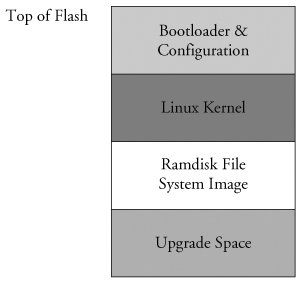Книга: Embedded Linux Primer: A Practical, Real-World Approach
2.3.3. Flash Usage
2.3.3. Flash Usage
An embedded system designer has many options in the layout and use of Flash memory. In the simplest of systems, in which resources are not overly constrained, raw binary data (perhaps compressed) can be stored on the Flash device. When booted, a file system image stored in Flash is read into a Linux ramdisk block device, mounted as a file system and accessed only from RAM. This is often a good design choice when the data in Flash rarely needs to be updated, and any data that does need to be updated is relatively small compared to the size of the ramdisk. It is important to realize that any changes to files in the ramdisk are lost upon reboot or power cycle.
Figure 2-4 illustrates a common Flash memory organization that is typical of a simple embedded system in which nonvolatile storage requirements of dynamic data are small and infrequent.
Figure 2-4. Example Flash memory layout

The bootloader is often placed in the top or bottom of the Flash memory array. Following the bootloader, space is allocated for the Linux kernel image and the ramdisk file system image,[8] which holds the root file system. Typically, the Linux kernel and ramdisk file system images are compressed, and the bootloader handles the decompression task during the boot cycle.
For dynamic data that needs to be saved between reboots and power cycles, another small area of Flash can be dedicated, or another type of nonvolatile storage[9] can be used. This is a typical configuration for embedded systems with requirements to store configuration data, as might be found in a wireless access point aimed at the consumer market, for example.
- 2.3.2. NAND Flash
- 1.2.6 Flash EEPROM
- Рабочая среда Flash
- Flash 8 и Flash 8 Professional
- Справочник по Flash
- Flash-накопители
- В Интернете можно найти большое количество игр, баннеров и меню, сделанных во Flash. Можно ли самому создать подобную ан...
- Переносные устройства на основе flash-памяти
- Measuring Key Buffer Usage
- Printing Resource Usage with top
- 2.3.1. Flash Memory
- 2.3.4. Flash File Systems




